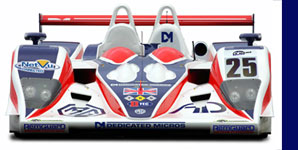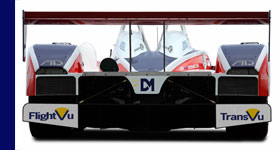The start of the 2008 saw RML introducing a further evolution
of the original MG Lola EX257sports prototype contender,
the MG Lola EX265.
This
was a direct development of the team's Le Mans-winning LMP2
EX264, and the extent of further work carried out on the
chassis during the course of the Winter of 2007-8, particularly
with regard to the engine, warranted full re-homologation
of the MG. The result was the announcement in January 2008
of the arrival of the MG Lola EX265 (see news item here).
However, by the time the season reached its conclusion,
the designation had changed again, but while the underlying
car remained largely the same, the outwarrd appearance had
become markedly different.
After
a season on tackling the latest cars from Porsche, Zytek
and Lola with an LMP2 car that was, in some respects, several
years old, RML made the move forwards. In mid-September
2008, after weeks of total secrecy, the new RML MG Lola
EX265C broke cover, and it was a coupé.
Outwardly,
there had been few distinguishing features to mark the EX265
as significantly different from its predecessor, the 264,
but the same could not be said of the EX265C. With its smooth
curves and profiled cockpit, it looked quick when it wasn't
even moving.
Under
the skin, however, the heart of the 265 survived, and much
of the work carried out to hone what had been a very successful
sportscar survived. Photographs of the last-ever MG racecar
are now featured widely here on the site, and visitors are
urged to visit two news pages where coverage of the announcement
is given, followed by a report on the shakedown test at
Snetterton.
The
following details apply to the EX265 open-topped LMP2 contender,
but mechanical and technical details were largely unchanged
for the coupé.
The
major advance over the earlier EX264 lay within the two-litre
turbocharged engine. Based upon AER's well-proven PO7 engine,
the EX265 was powered by the re-designated XP-21 unit. This
revived the original association between MG, Lola and AER
that began with the MG EX257 in 2001, when the works cars
at Le Mans were powered by the AER-derived XP-20. In addition,
collaboration between RML and chassis developers Lola had
achieved further advances in handling, aerodynamics and
overall performance of the car, allowing the EX265 to make
full use of the improved characteristics of the XP-21 engine.

The
EX265 was the last in a long line of technologically advanced
and aesthetically pleasing MG racecars to emerge from the
Lola factory in Huntingdon. Over 8000 hours of CAD development
work went into the design of the original EX264, while some
260 hours were spent in the windtunnel to perfect the car's
aerodynamics.
In
its original configuration, as raced in 2005, the EX264
was initially developed in association with MG, RML and
engine specialists Judd. Based on the Lola B05/40, itself
a comprehensive redevelopment of the successful MG EX257
sports prototype, the EX264 was immediately eligible for
the ACO LMP2 class at Le Mans as well as the Le Mans
Endurance Series (now Le Mans Series) and
the American Le Mans Series. In its final incarnation,
the MG EX265 complied with all the latest regulations and
technical specifications.
 Although
visually similar to other Lola chassis,
RML's family of racecars is correctly designated as MG -
be that last season's EX264, or the EX265 through to the
end of 2008. (Not, as has been contrived by some, an "MGola",
which seems a cumbersome name for such a svelte and nimble
car!). Under the skin it featured many significant differences
that stood it apart from its Lola, Mazda or Acura - badged
counterparts. Many of these stem from the way RML continued
development of the previous MG EX257 after acquiring the
ex-factory racecars and campaigning those in 2003 and 2004.
Much of that on-going development was too valuable to be
lost when the B05/40 chassis was released, and with the
blessings of both Lola and MG (at that time still in operation),
many of those innovations were carried over to the new car.
Several months before the demise of MG Rover as a British
company, the new RML racecar was fully homologated as the
MG EX264. Subsequently, with the revival of the MG brand
and closer ties between RML AD Group and the MG parent company,
Shanghai Automotive in China, the RML sports prototype continued
to carry the MG octagon and to promote the brand world-wide.
Regrettably, the relationship came to an end in late 2008
after protracted negotiations failed to reach a satisfactory
conclusion, and RML AD Group's six-year period of "flying
the flag" for MG came to an end.
Although
visually similar to other Lola chassis,
RML's family of racecars is correctly designated as MG -
be that last season's EX264, or the EX265 through to the
end of 2008. (Not, as has been contrived by some, an "MGola",
which seems a cumbersome name for such a svelte and nimble
car!). Under the skin it featured many significant differences
that stood it apart from its Lola, Mazda or Acura - badged
counterparts. Many of these stem from the way RML continued
development of the previous MG EX257 after acquiring the
ex-factory racecars and campaigning those in 2003 and 2004.
Much of that on-going development was too valuable to be
lost when the B05/40 chassis was released, and with the
blessings of both Lola and MG (at that time still in operation),
many of those innovations were carried over to the new car.
Several months before the demise of MG Rover as a British
company, the new RML racecar was fully homologated as the
MG EX264. Subsequently, with the revival of the MG brand
and closer ties between RML AD Group and the MG parent company,
Shanghai Automotive in China, the RML sports prototype continued
to carry the MG octagon and to promote the brand world-wide.
Regrettably, the relationship came to an end in late 2008
after protracted negotiations failed to reach a satisfactory
conclusion, and RML AD Group's six-year period of "flying
the flag" for MG came to an end.
 The
chassis is an all-carbon fibre monocoque, with symmetrical
twin rollover hoops. This is encased within a stunningly
good-looking bodyshell constructed from pre-preg carbon
fibre with a honeycomb core for additional rigidity. This
met the revised aerodynamic requirements introduced during
2004 and meant that the EX265 could remain at the forefront
of prototype racecar technology for several years. Indeed,
in 2009, several examples of the similar Lola B07 chassis
are stil in active competition. The rear wing and underbody
are also of lightweight carbon composite construction.
The
chassis is an all-carbon fibre monocoque, with symmetrical
twin rollover hoops. This is encased within a stunningly
good-looking bodyshell constructed from pre-preg carbon
fibre with a honeycomb core for additional rigidity. This
met the revised aerodynamic requirements introduced during
2004 and meant that the EX265 could remain at the forefront
of prototype racecar technology for several years. Indeed,
in 2009, several examples of the similar Lola B07 chassis
are stil in active competition. The rear wing and underbody
are also of lightweight carbon composite construction.
The
front and rear suspension uprights are fabricated from aircraft
specification steel and TIG welded. These elements link
via double fabricated steel wishbones with pushrods and
rockers to three-way adjustable damper units.
In
2005 the car raced with a specially-developed MG V8 powerplant,
created exclusively for the EX264 by Judd. Normally aspirated,
this unit took the car to a class win at Le Mans in June
2005 and proved both reliable and strong, rarely missing
a beat all season. Having enjoyed fantastic support from
Judd all year, it was not an easy decision to take when
the team found it necessary to change engines for 2006,
reverting to the turbocharged AER 2-litre engine that had
previously powered the team's EX257s. Not only did RML already
have several of these engines "in stock", but
over the previous two seasons the AER unit had proven itself
exceptionally reliable, fuel efficient and responsive. It
made sense, both financially and in terms of race strategy,
to make the change. As was subsequently demonstrated by
a second consecutive class victory in the Le Mans 24 Hours
of June 2006, the change proved to be a wise one.
In
2008 the engine was replaced again, this time by the AER-developed
XP-21, mated to a Lola six-speed sequential gearbox with
semi-automatic paddle shift system. A back-up manual gear-change
system is also installed. When first introduced, this back-up
required that a driver with paddle-shift problems made a
40 second pitstop to initiate the changeover. However, later
refinements meant that only a very brief moment of free-wheeling
was required in order to affect the switch, so the car did
not even have to stop. Two starter motors and paired alternators
were fitted for reliability, lightweight magnesium castings
were employed extensively throughout the car, and braking
was by 355 mm diameter carbon discs.
In
2007 Lola introduced the revised B07 chassis, and made available
an updated aerodynamic kit for the earlier B05 and B06 chassis.
RML carried out extensive testing and back-to-back simulations
on these configurations, and in 2007 employed both variants,
favouring new "07" body kit at high downforce
circuits but remaining faithful to the "06" kit
for the lowest downforce tracks. During the 2007-8 "closed
season" the team carried out further dynamic testing
on both the body and chassis of the EX265 and has now achieved
significant improvements in handling and performance.
The
EX265 was fitted with a fully-integrated computerised dash/data
logger system with steering-wheel mounted display. The military-specification
wiring loom is installed directly to the inside of the monocoque
for protection, access and reliability. The car also carried
examples of AD Group's latest technology in video monitoring
and on-board camera equipment, allowing team and drivers
alike to review and assess all aspects of the car's on-track
performance.
The technical specification listed below
relate to the car as prepared for the Le Mans 24 Hours
in June 2006, fitted with the MG XP-21 AER turbochared
engine. For the specification of the earlier EX264, please
click this link: MG
Lola EX264. Distinguishing between
the two is made easy by the presence of the air intake
between the roll hoops on the V8-powered car, and the
single periscope inlet to the side of the cockpit on
the turbocharged EX265.
 |
| Engine |
MG AER XP-21 2.0 litre turbocharged 4-cylinder
|
| Power |
Approximately
500bhp through 1 x 42mm restrictor |
| Top
speed |
In
excess of 200mph |
| Gearbox |
6-speed
semi-automatic sequential via paddle-shift |
| Clutch |
Carbon,
pull type |
| Cooling |
Aluminium
water radiators and oil coolers |
| Chassis |
One
piece carbon fibre monocoque |
| Steering |
Power
assisted rack-and-pinion |
| Suspension |
Fabricated
steel double wishbones |
| Brakes |
355mm
x 32mm front and rear, Carbon fibre discs, carbon
fibre pads |
| Wheels |
Forged
Magnesium Fronts 18"x12.5J, Rears 18"x13J |
| Tyres |
Michelin.
Fronts 300/650-18, Rears 310/710-18 |
| Dimensions |
Length,
4534mm; Width, 1990mm; Wheelbase, 2790mm |
| Weight |
Minimum 825 kgs |
| Capacities |
Fuel,
80 litres, Oil (dry sump) 10 litres |
|
These
specifications are subject to change and were correct for
the EX265 as of April 2008
